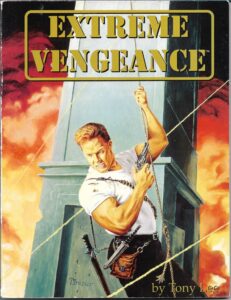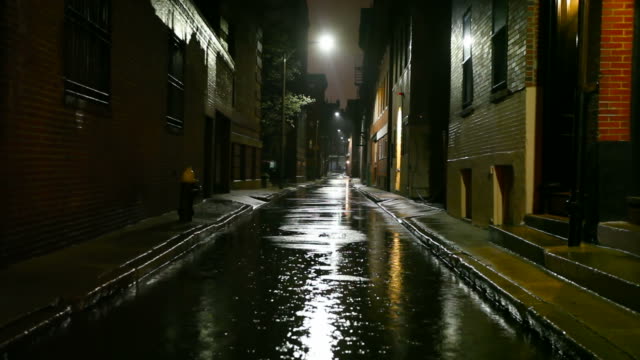Back in July, I played a “movie” of Extreme Vengeance with Denica and Nathan, in three sessions. This game is from 1997, with a discussable publishing history, and I later met and talked with its author, Tony Lee.

As with a couple of similar games from around this time, the concept is that you play an action star’s persona, or schtick – not the actor and not the character. Or rather, you play different movies as you go along, with variations in backstories and details, but maintaining the persona. Because I’ve seen people get the wrong idea about this, I stress that all play is diegetic (“in-fiction”); there is no played reference to movie-making, actors’ point of view, or self-awareness about it. The procedures use the cinematic idiom for the real people’s enjoyment, most festively in fact, but inside the fiction, it’s not a parody or self-reference.
For example, in our game, Denica created and played Ronya Rox, who would certainly star as her characteristic bumbling outlaw self in many a shoot’em-up or punch’em-out or sorcery-and-sandals obscure epic, but each would have its own diegetic character for her to “be.” So in this film, “Night Streets 2,” Ronya Rox’s character is named Betsy. Similarly, Nathan’s hero is Shoe Scogan, who is reliably his characteristic gung-ho fighter self in any and every film, but in this film, he has “no name” in the fiction as a kind of edgy gimmick.
Actually let me back up. I’d played a brief session with Johan and someone else a little while before this, It was pure sword-and-sandals pulp action, involving radioactive-looking purple magic, sacrifices at a poor downtrodden village, a brutal bandit, and a demon goddess named Tentacula. Here are the character sheets and the result of one of them using the Cue Card.
Although we didn’t do the whole movie, it confirmed to me that the concept is quite accessible and also reminded me that I needed a fair amount of preparation; it’s not a good game for constant GM-improvised content.
So, afterwards, that thought led me to bring a quick summary of “what sort of movie are we making” to the game I’m talking about:
This choice has nothing to do with making the characters, who are topic-neutral except for action cinema in general. Therefore, after making the characters, we chose “dark streets & gritty crime.” I arrived at the title after we played the first session.
Here are some rules to know as you look at the character sheets.
- Throughout a film, a character’s Guts goes up die by die due to suffering defeats, and their Coincidence goes down, by one die at each use.
- Wounds are suffered only within single scenes and clear for each next scene; one has Wounds (or rather capacity) equal to Guts but Guts is not reduced by Wounds. If you take your capacity within a scene, you are taken out of the action somehow.
- Repertoires are used up per film, e.g., if you have Avenging Fury (2), it means you can use it twice. There isn’t any replacement during the whole film.
- Different Repertoires operate at different scales: scene, sequence (basically combat round), or action. For example, Cutaway may be applied at any point during a whole scene, whereas Slo-Mo applies only to a Sequence, and Zoom applies only to a single damage roll. It’s important to understand which of your Repertoires applies to which scale-unit of play.
This is my first preparation notes page:
And, crucially, now that I felt more grounded in the system and in the current content through play, my developed preparation which I used throughout sessions 2 and 3.
[Perhaps appropriately, my recordings ran into serious trouble: a lighting input problem for session 1 and fogged camera lens for session 2. You might charitably call the results “atmospheric,” thanks.]
In case you wondered about the sophistication and depth of straight-to-video “Night Streets 2,” starring obscure leads Shoe Scogan and Ronya Rox, here’s a quick summary. The top boys of the Scarlatti crime syndicate insiders didn’t like Mr. Scarlatti’s girlfriend Rose and his desire to go legitimate with everything. They turned her over to Father Gianni at St. Mary’s Cathedral, knowing they’d never see her again. Now they’re being killed off one by one, crucified alive and sliced apart, finished off with a single bullet. Our heroes investigate at Mr. Scarlatti’s request (and distrust for his top boys, and desire to keep the police out of it). A strange gang seems to have arisen from and near the church, committing similar atrocities at random and tagging everything with distorted religious graffiti. Rose’s friend Elise is trying to find out what happened to her. It turns out Rose is still alive (? or?), and crazy (or animated by nothing but revenge?). But our endearing con-artist Betsy is desperate and her unnamed fighting-man is driven by a dark vengeance of his own. Carnage ensues.
Some things we learned from playing out a full movie, something I haven’t done with this game for over twenty years.
- Repertoires aren’t over-rich after all, and for starting characters, there is a mild but real trade-off between high scores and how many Repertoires
- Using up Repertoires isn’t really about resource management anyway, but more about distinctions among characters and what sort of attacks each one can’t withstand
- Scenes-sequence-dice, as we fumbled badly in session 1 and worked out in discussion at the start of session 2
- The Excitement level procedure turns out to be a design problem, fundamentally broken in concept; it’s better to treat the relevant Repertoires as adding dice
- Attacks should use those weapon damaging rules, which I think I totally forgot. I had real trouble dinging the heroes well enough to trigger a bunch of productive procedural responses.
- A player should really be prepared to eat scene-level defeats as part of the fun. There’s no point at all in trying to protect your character’s flesh, as its tenderness is there to be sullied – it will be fine for the next scene, after all. [A related point is to apply your No-Goods early and often; think of them as easy ways to get defeated and therefore increase your Guts.]
- I’ve also realized that the improvement system is poor, as it’s merely bloat: you get more Guts, more Coincidence, and more Repertoires, and that’s it. I get that a given character might benefit from one or two Repertoires that they don’t start with as a form of specifity and clarification (Ronya Rox should totally have Preferential Treatment, for example), but past that point it’s extremely counter-productive. Action and events are already good, and there’s no reason to inflate them; also, the characters benefit from being distinctive, and continuously beefing up attributes and adding more abilities would only result in convergence.
What I’ll say now is backstopped from having talked with Tony. The intent of the game is not merely to re-play 80s action movies like fanfic, but to be able to make them in good faith and good fun among people who like them. But along with his unfortunate stylistic choice to be parodic with the text, I think the whole culture of 1990s RPG writing hampered his ability to say so. Game text at that time was expected to deliver, in this case through some automated quality, such a movie. The potential for established story features in tandem with open-for-play features was simply not known, or at least could not be clearly expressed. (Some of you will note my similar comments concerning Over the Edge, The Whispering Vault, Zero, Maelstrom/Story Engine, and indeed Hero Wars.)
My solution is to focus less on set-piece staging and more on an information-rich environment: things to discover and things which can happen. I think it fits much better with the working rules as written, because player-triggered repertoires like Cutaway, Cue Card, and others require external, GM-responsive content.
That said, we also need truly vicious fights and locations full of dangers so the heroes can experience defeats. Therefore a GM’s preparation is similar to older Champions: one must be ready with potential set-pieces associated with the villainous opponents, which may or may not see use in play, and one must also be comfortable with making off-the-cuff warehouses, nightclubs, cult temples, et cetera. In our case, no particular mayhem went down at the Scarlatti mob headquarters, but we did indeed make use of my hazards-laden prep for the crazy (haunted?) St. Mary’s Cathedral.
It’s difficult to get across why I think this game is important. It stands in strong contrast, for example, with Hong Kong Action Cinema, which I consider trivial. I’m not helped by painful aspects of the text, which is so jokey and self-deprecating that it ruins a reader’s understanding that this thing has an actual working system. Specifically, logical rules for input and procedures at every level of play: any/interstitial among scenes, for scenes as such, for sequences inside scenes, and momentary effects for actions inside sequences. If everyone plays with gusto at all of these levels, then plot and characterization appear without one person guiding and providing; moreover, given the right sort of preparation, plenty of content and surprising events may appear via these procedures. By which I mean, surprising to everyone.
I’m saying that the game’s definitely deterministic content – which is considerable – does not mean merely representational genre-repetitive play, but instead actually opens up non-determined play-specific, person-specific expression. Whatever procedural quibbles may be involved, as in my list above, that’s something to learn from.


4 responses to “Night Streets 2”
Ha, and here I was thinking I’d struck upon something kind of new when I started playing around with systems involving trading early failures against later success some ten years ago … 🤭 Of course my players never got it. There seems to be a strong desire to always ‘win’, no matter how much or how little is at stake, among many players, something one of my friends readily admitted.
This game is really gentle in this regard, because the failure is genuinely nothing but a plot event, meaning, content to use. There’s no reduction in resources or “damage” or risk of being knocked out of play. But I know what you mean – I’ve seen, even in playing this game, the reaction to failure or being really skunked in a fight, as if the player had been physically struck themselves in real space.
Yes, failures were nothing serious game wise but *still* players resisted, although failures would earn them better shots later on when things got serious mechanics wise. I had expected the opposite problem of players using meaningless failures to beef their characters up. I assume this might have happened with other players.
Still having trouble replying in the right thread. I’m using my cell phone so maybe that’s why. (There was a Reply button on my own post but not on yours that I could see.)